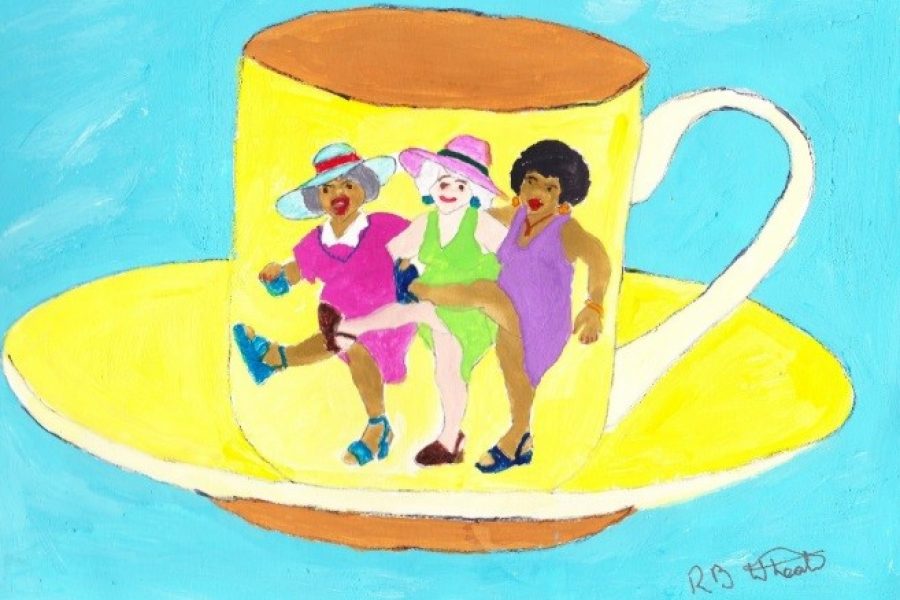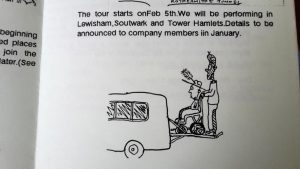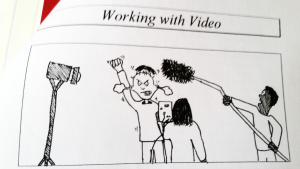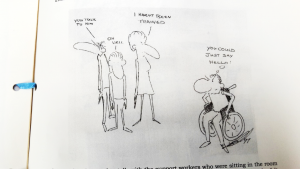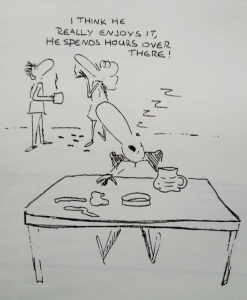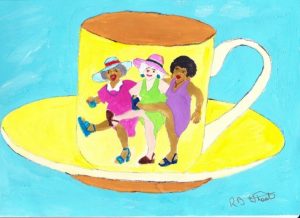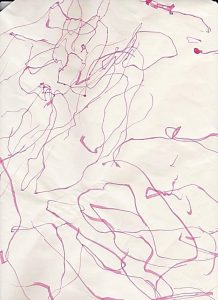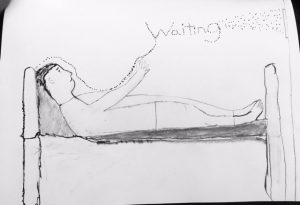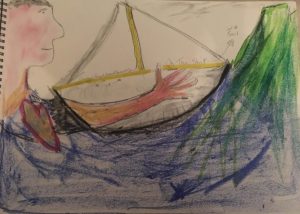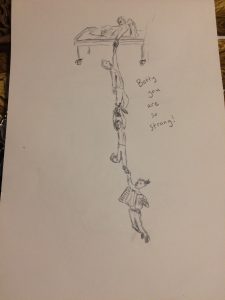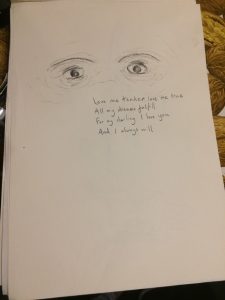Archive blog: Communication in a Nutshell
by Rebecca Swift, Creative Director
Communication in a Nutshell: When Drawings and Cartoons become Data
Looking back at Entelechy Arts history becomes a fascinating process of uncovering forgotten data. Recovering this ‘old’ information, which lives below the surface of our memories, brings into view previously out-of-sight and out-of-mind potential. Retrieved fragments of data illuminate how things inter-connect in different ways over time, placing into relief a previously unseen, unbroken thread.
In this blog post we explore visual data starting from the very beginning of Entelechy Arts history –in the heyday when we were called New Moves – manifesting in drawings, symbols and cartoons. From the early 1990’s to the present-day hand-drawn cartoons and drawings, both abstract and literal, appear throughout our work. These visual pieces documented, made sense of, and informed people of what we did. Images created by our members, artists and volunteers alike, were and are still used to capture our work, sometimes where words fail. Drawings are intrinsic to our work as they:
- can permeate across difference- whether that be different organisations, groups sectors or institutions.
- diversify how we might evaluate and make sense of experience: data normally revolves around interviews and surveys, which on its own can be limited.
- are an immediate and spontaneous way of communicating our work.
- capture complexity in one frame.
- delineate data that is more intangible and sensed.
- share information in a way that is inclusive and accessible and allows input from people where verbal communication is difficult.
Through simplicity cartoons brought the practise into visibility
In the early 1990’s, volunteer Alex Slater (aged 8) co-designed Entelechy Arts brochures and AGM reports with quirky, humorous and accessible illustrations. Entelechy Arts was a small village of a company with a simple but innovative output.
These hand drawn comic style images were used to communicate the work to our members, so they could make an informed choice about how they might like to take part. Images reached out to the whole Entelechy Arts community, particularly to those members who had a learning disability. They were an accessible and transparent communication tool which everyone could relate to.
Looking back, these designs appear refreshingly innocent, witty, observant and bounce off the page. As a result, formal documents like an AGM report had a hand made quality to them that was personalised, fun and human. I particularly like the chain-smoking stressed treasurer (above left). The comic genre in no way airbrushes out the strain of running a charity.
Cartoons portrayed difficult situations in ways others could receive.
This tradition of illustrating our AGM reports with cartoons continued with Entelechy Arts’ first apprentice, Pete Jarman. Pete-who is currently an Entelechy Arts’ trustee- joined Entelechy Arts via Rotherhithe Theatre Workshop (RTW) in the 1980’s at the age of 12. He performed in theatre pieces co-directed by David Slater with the local community in the housing estate where he lived. The 1996/97 AGM report is peppered with cartoons like this:
Pete’s cartoons married a mischievous sense of humour with sharp observations on everyday exclusion. In the report they appear next to writing about advocacy, at a time when Entelechy Arts was setting up an advocacy programme for adults with learning disabilities.
By 1996 our AGM reports allowed contrasting ways of describing our work to sit side by side: academic writing, cartoons and handmade drawings coexisted on the same page. However, by the late 1990’s reports and leaflets became more formal and finished; photos with quotes became the mainstay of visual communication and drawings disappeared from reports.
A succinct design language in painting
This 21st Century Tea-Dance emblem was painted by Entelechy Arts member and artist Rosie Wheatland, to advertise our Albany Theatre Tea Dance in 2014. Rosie’s design beautifully expresses the essence of an Entelechy Arts knees-up. She distils and superimposes different ingredients where teacup as symbol frames the action. Several qualities are conveyed at once about the atmosphere, taste, content, sound and movement. It clearly and inclusively communicates to a diverse inter-generational audience what the event might be like.
Synaesthesia as a style in drawing to capture multi-sensory work
In 2006 painter Ertac Mentesh joined Entelechy Arts’ multi-sensory Ambient Jam programme for adults with complex disabilities. He documented the unfolding dance and music improvisation of each weekly session. His colourful paintings, full of vitality, were an interpretation of the way music, shapes of instruments, movement of people and atmosphere interwove. His designs and symbols expressed and communicated to others what the present moment evoked in him, as much as what he saw. Bottom right: Ertac Mentesh shows a market stall holder his drawing of an Ambient Jam project of Deptford Market,2008.
Photograph by Nichole Rees, 2008
Above left, is a recent sketch by Ertac of musician Merlin Hayward playing her drum in an ‘Ambient Jam collective’ improvisation, which took place at the Goldsmiths centre for Contemporary Art. Ertac was drawing as part of the improvisation and this piece arose from a felt response to the stimuli that happened around him. He touches on a truth about Merlin’s playing: Merlin and drum merge, so that the drum extends into a person with head and legs.
In a multi-sensory landscape where there is less separation between the senses, his portrayal cleverly amplifies the embodied way she began to play. This emblem captures a sensed truth, where a quality of synaesthesia in an improvisation- when the senses and media overlap – is mirrored in the style of his drawing. The expressionistic and vibrant draft skills of Ertac’s own unique style also takes this concept further.
Non-verbal media articulating non-verbal experience
In 2016 with a new Ambient Jam programme for young adults with complex disabilities, the team of artists and members would check-in after each session by using drawings. These quick, spontaneous sketches were a way of making sense of what had just happened. The non-verbal language of drawing sometimes better reflected the often subtle, non-verbal, sensory environments of these events. In keeping with the lateral, physical quality of an Ambient Jam, the drawings were often more abstract. They captured essences, such as the flow of movement or sound, and shifting perceptions of time or space.
Drawings created in 2016
Above left, Jenny, who has profound autism and is visually impaired, drew these cascading marks of energy, straight after a session – each mark, making a sound and rhythm on the paper as she drew. It would be interesting to find out if her drawing would have been any different before the session. Sublimely abstract; her drawing conveys a pulse-like, energetic essence. Her actions of mark making were full of movement and rhythm.
In evaluating the work could we have captured this in words? To the right is a drawing by musician Jai Channa after the same session: A footprint connects the session to the tactile proximity of the ground; and illustrates how sound, space, movement, people, and touch superimpose as one – as if time didn’t exist. Again there is an element of synaesthesia as all ingredients overlap within one frame; a frame with a boundary that doubles up as a footprint, encapsulating time and space as one within its borders.
Drawings process experience, capturing the relational space between people
We end with a few examples of a large body of visual work currently being explored by a team of dance artists and musicians, working long- term at Tower Bridge care home. Artists embedded in both Tower Bridge care home and Alexander Care home have been adapting Ambient Jam improvisation to creative work with residents. The artist’s work is deeply responsive to site and the present moment, and often takes place by resident’s bedsides, in corridors and communal spaces: within palliative care, nursing care and dementia units of the home, where residents have less access to outside events.
At Tower Bridge care home, dance artist Cai Tomos has introduced a way of using drawing to help artists check-out after they have finished for the day. Initially, Cai did these drawings to capture unsaid experience slightly below conscious radar, as a means of self-care so that the stories and experiences he unconsciously absorbed could be let go of at the end of the day.
However, the team felt these drawings also captured the essence of what was really happening in the home, including the creative work. The drawings made sense of the journey residents were experiencing and synthesised sometimes disparate information about the creative exchange between the artists, residents and staff. Images captured sensed but not quite fully conscious thoughts – things much harder to put into words. And like some of the cartoons they were a good way of sharing what was also difficult as well as joyful. Like all the drawings mentioned in this blog, there is something uniquely succinct about these images, conveying complexity in one frame, or an essence very difficult to grasp, a sensed moment of transition. They also suggest, like a working score, what to build on in the future.
Drawings by Cai Tomos, responding to a resident in palliative care who helped us all imagine the care home as a big ship traveling back to where he was born.
Musician Robyn Clarke who recently joined the team was inspired by Cai’s work. He also began to sketch his experience of often fleeting moments, playing songs with the residents.
Their work captures the vulnerability and intimacy of connection within the cultural space, created by improvisation in a care home, where private often seeps into the public zone.
Drawings by Robyn Clarke playing his accordion by people’s bedsides.
Conclusion
Drawings facilitate a different way of evaluating and disseminating our work by communicating our experience non-verbally: they enable a wider diversity of people to input into making sense of what we do. Visual data can innovate how we vision strategy, by expanding the frames of reference and including and capturing other ways of seeing things, and new information. Drawings often get straight to the point of something. They can make what is harder to see, more visible. They distil complex, contradictory and layered dynamics into one frame, so you can see several things happening at once. They illustrate aspects of our experience we might smooth over in the verbal telling. In this way drawings don’t seem to lie. They can be profound and funny, accessible and uncompromising, and come in all shapes and sizes. They speak for themselves and bring humanity into wider formal discourse.

